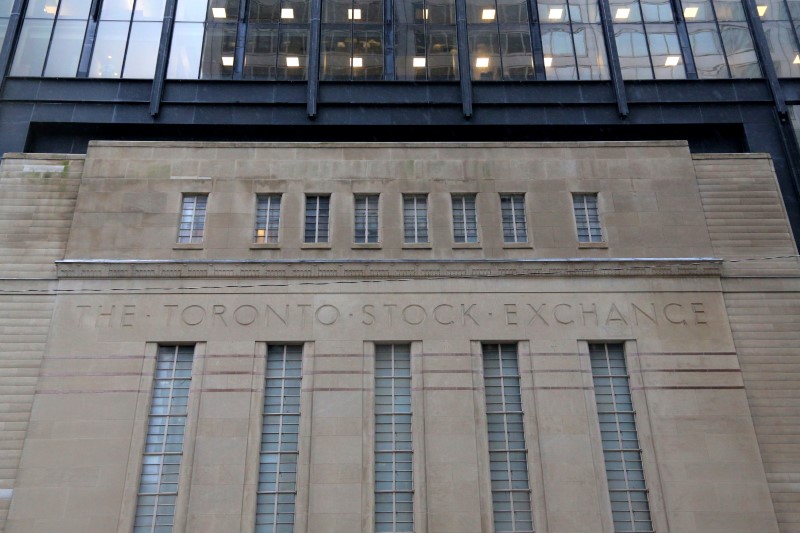China accuses US of orchestrating $13 billion Bitcoin theft
Investing.com - Canada’s main stock exchange was lower on Thursday, after the index notched a fresh record peak in the prior session.
The S&P/TSX composite index shed 182 points or 0.6% at 30,454.58.
Index gained 0.9% to end at 30,637.12 on Wednesday, surpassing a previous all-time closing high on October 6. The TSX has now soared 23.9% so far this year, outpacing the benchmark S&P 500.
Underpinning much of the advance were metals and mining stocks, which have been bolstered in large part by a jump in the price of gold. The yellow metal topped $4,200 an ounce for the first time ever earlier this week.
Materials, a sector that folds in metal and mining shares as well as fertilizer firms, added 3.2%.
U.S. stocks rise
U.S. stock futures rose Thursday, as investors digested more corporate earnings amid growing expectations that the Federal Reserve could cut interest rates again this month.
The Dow Jones Industrial Average lost 301 points, or 0.65%, the S&P 500 index lost 42 points, or 0.6%, and the NASDAQ Composite lost 107 points, or 0.47%.
The S&P 500 and tech-heavy Nasdaq Composite advanced on Wednesday, while the blue-chip Dow Jones Industrial Average ended slightly lower. An initial surge in equities waned somewhat during the session, as markets poured through broadly upbeat earnings from European chip titan ASML and major Wall Street lenders Bank of America and Morgan Stanley.
Wall Street supported by Fed easing bets
Sentiment has been boosted this week by raised expectations of Fed easing later this month. Federal Reserve Governor Stephen Miran on Wednesday called for quick rate cuts, citing the economic risk of a further strain in U.S.-China trade relations.
The remarks arrived a day after Fed Chair Jerome Powell’s dovish comments reinforced bets that the central bank will roll out rate reductions at its last two meetings of 2025.
However, signs of rising friction between Washington and Beijing capped Wall Street’s rise. Treasury Secretary Scott Bessent added to fears of a trade war, saying in a CNBC interview that the Trump administration isn’t likely to back down from its tough negotiating stance even if markets react negatively.
Trump has floated cutting off trade ties with China in the cooking‐oil space, accusing Beijing of “purposefully not buying” U.S. soybeans.
Traders will be keeping tabs on a gauge of manufacturing activity in the U.S. Mid-Atlantic region later in the session, as a prolonged U.S. government shutdown causes a delay to fresh economic data.
The Federal Reserve Bank of Philadelphia’s monthly manufacturing index is tipped to stand at 8.6 in October, down from a reading of 23.2 in the prior month. A positive reading suggests expansion in the sector.
United Airlines results in focus
There are more corporate stories to digest Thursday, with United Airlines shares falling premarket despite the carrier reporting third-quarter earnings that beat Wall Street estimates, as well as forecasting record revenue for the current quarter.
Salesforce’s stock price jumped premarket after the cloud software company raised its long-term revenue target to more than $60 billion by 2030 and unveiled a $7 billion share buyback program.
Elsewhere, Oracle is due to hold a meeting with financial analysts at the cloud software group on the final day of its AI-focused conference in Las Vegas on Thursday.
Taiwan Semiconductor Manufacturing Co. clocked a record third-quarter profit, powered by soaring demand for AI infrastructure.
Gold climbs
Gold prices rose to fresh record highs, marking a fourth straight session of all-time peaks, as rising expectations for Fed rate cuts and the U.S.-China trade tensions lifted demand for the safe-haven metal.
Spot gold rose 1.3% to $4,256.65 per ounce, after reaching as high as $4,241.99 earlier in the session.
Bullion has jumped by more than 6% over the past one-week period.
Crude spikes
Oil prices surged higher Thursday on expectations of tighter global supplies after U.S. President Donald Trump stated that India agreed to stop buying oil from Russia.
Brent futures gained 0.4% to $66.17 a barrel, and U.S. West Texas Intermediate crude futures rose 0.5% to $58.57 a barrel.
The prospect of India, one of the world’s biggest oil importers, seeking oil from alternative sources pointed to tighter supplies in the coming months.
Both benchmarks touched their lowest since early May in the previous session on U.S.-China trade tensions and after the International Energy Agency warned of a big surplus next year.
